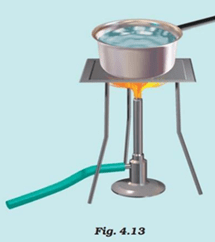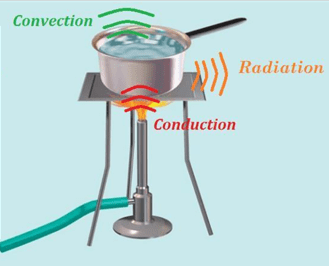NCERT Solutions Class 7 Science Chapter 3 Heat is provided here to help students in understanding the topic thoroughly. All these solutions are solved by experts with a detailed explanation. Class 7 NCERT Solutions for Science Chapter 3 includes all the textbook exercise questions and answers. These solutions will help students complete their assignments & homework.
Class 7 Science Heat Questions and Answers
Exercise Questions
Question 1: State similarities and differences between the laboratory thermometer and the clinical thermometer.
Answer:
Similarities:
- Working principle of both the thermometer is same.
- Both are used to measure temperature.
- Both have a thick-walled glass tube enclosing a fine uniform bore capillary tube.
- Mercury is used in both thermometers to measure temperature.
- Both have Celsius and Fahrenheit markings.
Differences:
- Laboratory thermometer is used to measure the temperature of different objects in factories and laboratory whereas clinical thermometer is used to measure the temperature of human beings only.
- Generally, laboratory thermometer has a temperature range from −10℃ to 110℃
- Clinical thermometer has a temperature range from 35℃ to 42℃.
- Usually, laboratory thermometer does not have any constriction whereas clinical thermometer has the small constriction near the mercury bulb.
- Laboratory thermometer has to be kept upright while taking the reading whereas clinical thermometer can be tilted while taking reading.
Question 2: Give two examples each of conductors and insulators of heat.
Answer: Conductors: Copper, aluminium and iron.
Insulators: Wood, water and air.
Question 3: Fill in the blanks
(a) The hotness of an object is detetmined by its ____________ .
(b) Temperature of boiling water cannot be measured by a ____________ thermometer.
(c) Temperature is measured in degree ____________ .
(d) No medium is required for transfer of heat by the process of ____________.
(e) A cold steel spoon is dipped in a cup of hot milk. It transfers heat to its other end by the process of ____________
(f) Clothes of ___________ colours absorb heat better than clothes of light colours.
Answer:
(a) The hotness of an object is determined by its temperature.
(b) Temperature of boiling water cannot be measured by a clinical thermometer.
(c) Temperature is measured in degree Celcius.
(d) No medium is required for transfer of heat by the process of radiation.
(e) A cold steel spoon is dipped in a cup of hot milk. Heat is transferred to its other end by the process of conduction.
(f ) Clothes of dark colours absorb more heat better than clothes of light colours.
4. Match the following:
| Column-I | Column-II |
| (i) Land breeze blows during | (a) summer |
| (ii) Sea breeze blows during | (b) winter |
| (iii) Dark coloured clothes are preferred during | (c) day |
| (iv) Light coloured clothes are preferred during | (d) night |
Answer:
| Column-I | Column-II |
| (i) The land breeze blows during | (d) night |
| (ii) The sea breeze blows during | (c) day |
| (iii) Dark coloured clothes are preferred during | (b) winter |
| (iv) Light coloured clothes are preferred during | (a) summer |
Question 5: Discuss why wearing more layers of clothing during winter keeps us warmer than wearing just one thick piece of clothing.
Answer: During winters, we prefer wearing more layers of clothing than just one thick piece of clothing because air gets trapped in between the various clothing layers. Being a poor conductor of heat, air prevents heat loss from our body. Hence, layers of clothing keep us warmer than a single layer.
Question 6: Look at Fig. 4.13. Mark where the heat is being transferred by conduction, by convection and by radiation.

Answer:

Question 8: One litre of water at 30°C is mixed with one litre of water at 50°C. The temperature of the mixture will be
(a) 80°C
(b) more than 50°C but less than 80°C
(c) 20°C
(d) between 30°C and 50°C
Answer: (d) between 30°C and 50°C
Question 9: An iron ball at 40°C is dropped in a mug containing water at 40°C. The heat will
(a) flow from iron ball to water.
(b) not flow from iron ball to water or from water to iron ball.
(c) flow from water to iron ball.
(d) increase the temperature of both.
Answer: (b) not flow from iron ball to water or from water to iron ball.
Question 10: A wooden spoon is dipped in a cup of ice-cream. Its other end:
(a) becomes cold by the process of conduction
(b) becomes cold by the process of convection
(c) becomes cold by the process of radiation
(d) does not become cold
Answer: (d) does not become cold.
Question 11: Stainless steel pans are usually provided with copper bottoms. The reason for this could be that:
(a) copper bottom makes the pan more durable
(b) such pans appear colourful
(c) copper is a better conductor of heat than the stainless steel
(d) copper is easier to clean than the stainless steel
Answer: (c) copper is better conductor of heat than the stainless steel
Having a good grasp over CBSE NCERT Solutions for Class 7 Science will further help the students in their preparation for board exams and other competitive exams. NCERT Solutions for Class 7 Science Chapter 3 Heat in Plants provided by CBSE Path help students to clear their doubts and to obtain good marks in the exams. All the solutions provided in this article are strictly based on the CBSE syllabus and curriculum.